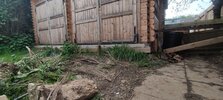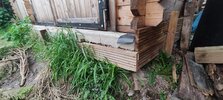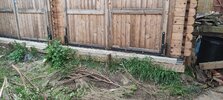Hello,
I moved into a house that has an end of garden workshop with a foundation that looked dodgy and had various tradesmen comment on the need to fix it before moving any workshop tools into the workshop.
It's on a slight slope and the shuttering for the concrete slab has not held up during the pouring. It's on hardcore, but it hasn't been compacted well. It's less than 10 cm thick, maybe around 7 cm mostly. Due to the slope, the front has hardcore gravel crumbling away from the concrete base, leaving the edge overhanging and unsupported. Ideas from any brickies/builders here on how to fix it?
I'm told by a knoledgable builder, it should have been retained by brickwork to begin with, not timber shuttering and to try to dig for fondations at the front (where it's sloped and base has overhang proud of ground level), build brickwork on top of foundations and to the side of the concrete slab (until it levels off with the ground) and pour concrete between the new brickwork and old concrete base? I may have not understood everything we discussed, but just wanted to clarify what my options are?
I will upload a photo tonight. Googling only reveals people underpinning huge full size log cabin buildings in America. This is a relativly small job, yet vital to start using the space as intended.
Thanks!
I moved into a house that has an end of garden workshop with a foundation that looked dodgy and had various tradesmen comment on the need to fix it before moving any workshop tools into the workshop.
It's on a slight slope and the shuttering for the concrete slab has not held up during the pouring. It's on hardcore, but it hasn't been compacted well. It's less than 10 cm thick, maybe around 7 cm mostly. Due to the slope, the front has hardcore gravel crumbling away from the concrete base, leaving the edge overhanging and unsupported. Ideas from any brickies/builders here on how to fix it?
I'm told by a knoledgable builder, it should have been retained by brickwork to begin with, not timber shuttering and to try to dig for fondations at the front (where it's sloped and base has overhang proud of ground level), build brickwork on top of foundations and to the side of the concrete slab (until it levels off with the ground) and pour concrete between the new brickwork and old concrete base? I may have not understood everything we discussed, but just wanted to clarify what my options are?
I will upload a photo tonight. Googling only reveals people underpinning huge full size log cabin buildings in America. This is a relativly small job, yet vital to start using the space as intended.
Thanks!







